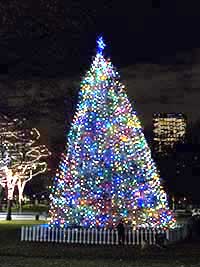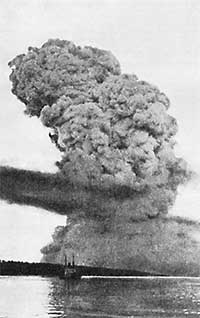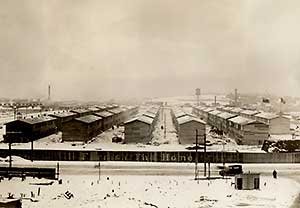A Gift Born of Heroism and Tragedy.

Every December families gather on Boston Common to light the city’s Christmas tree. A small sign explains that it is a gift from the people of Nova Scotia, yet many who see it don’t know what the gift is for. But it celebrates one of our city’s proudest moments, when selfless generosity brought crucial aid to a neighbor whose world had literally just been destroyed.
The Halifax Explosion. Sitting on the east coast of Nova Scotia, Halifax’s location makes it a natural hub for transatlantic shipping. During World War I it was the principal Canadian port for shipments to Europe and its harbor was crowded with steamers carrying troops, supplies and armaments. Two of them collided in a narrow channel on the morning of December 6, 1917. One caught fire and 20 minutes later its 3000 ton cargo of munitions exploded, instantly killing 1600 people and destroying thousands of buildings. It was probably the most powerful man-made explosion before the atomic age.
Boston Responds. A couple hours later a plea for help arrived at a Boston office from a Canadian railway official who had walked miles to find a working telegraph.2 Immediately a call was placed to a partner of the firm who was in a meeting at the State House. He informed the Governor, who telegraphed Halifax promising assistance and asking what was needed. The message never got through, however, since all communications with Halifax had been severed.

That afternoon a number of Boston’s leading citizens dropped everything to attend a meeting of the Massachusetts Public Safety Committee. Given the urgency of the situation, it was decided to send help without waiting for further details. A train departed North Station that evening carrying medicine, clothing and medical personnel. Abraham (Cap) Ratshesky, a Boston banker and civic leader, was in charge.
The train was given priority for the entire 750 mile trip, but nature didn’t cooperate. A severe snowstorm made the tracks impassable 75 miles from Halifax. An hour of hand digging, ramming and spraying steam freed the train, although three more hours of digging were later required to clear the last four miles. Finally the train rolled into Halifax at 7:00 a.m., thirty-three hours after leaving Boston. It was the first outside help to arrive.
Everyone Gets to Work. Although many had been up all night, the relief team immediately got to work coordinating efforts with local officials. Medical facilities were a top priority, so they located a serviceable building and by 6 p.m. cleaned it and installed an operating room. Sixty patients arrived by 9:00 p.m. and by noon the next day things were fully operational with 100 patients.
There was also a pressing need for housing since many homes near the harbor had been destroyed. Temporary apartments were built in a few weeks. When they opened in January 1918 they were among the largest apartment complexes in the world. Massachusetts donated $500,000 in furniture and set up a warehouse where people could select furnishings for their new homes.

The explosion had shattered windows everywhere, injuring hundreds as shards of glass were propelled like bullets. More than 800 suffered eye injury or blindness. The head of the Halifax School for the Blind requested assistance from the Perkins School, which he had attended as a student. The two schools developed programs to teach adults to cope with vision loss, pioneering a new field of therapy.5
Nova Scotia Says Thank You. On their final evening in Halifax, Ratshesky and his party were fêted at a dinner hosted by Nova Scotia’s Lieutenant Governor. Later Massachusetts Governor Samuel McCall visited Halifax as a guest of the City. He was toasted at receptions and banquets and awarded an honorary law degree. One of the temporary apartment complexes was named the Governor McCall Apartments.
As 1918 drew to a close, Nova Scotia sent the people of Boston a Christmas tree as a thank you gift. Then for fifty years Nova Scotia held no public commemoration of the disaster as survivors tried to put the it behind them.6 In 1971 the Christmas tradition was rekindled and a Nova Scotia tree was placed in the Prudential Center. More recently the trees have been sited on Boston Common near Tremont Street.
* * * * *
The story of the Halifax Relief Expedition shows what motivated and determined people can do even without our supposed technical sophistication, and how acts of compassion can create bonds that endure for generations. Following the 2013 Boston Marathon bombing the Government of Nova Scotia sent $50,000 for children’s relief while private citizens raised funds for victims and their families.
-----
- Information from this article comes from Laura MacDonald, Curse of the Narrows, Walker & Company, New York (2005); A.C. Ratshesky, Report of the Halifax Relief Expedition (1918); George Lyman, The Story of the Massachusetts Committee on Public Safety, Chapter V (1919); Joseph Scanlon, Rail Response to the 1917 Halifax Explosion, Canadian Rail, No. 461, pp. 143–53 (Nov.-Dec. 1997).
- The sender was George Graham, an official of the Dominion Atlantic Railway who after finding that all the wires to Halifax had been severed by the blast walked several miles to find a working telegraph in the neighboring town of Rockingham. Later that day the Canadian government commandeered the few working wires for official use.
- This photo may be the only image of the blast itself. It is believed to have been taken from about a mile away (Bedford Basin) 15 to 20 seconds after the explosion. Image from Wikipedia.
- Temporary housing under construction at Halifax Exhibition Grounds. Photo by Gauvin & Gentzel, January 26, 1918. Image from Nova Scotia Archives.
- See, Laura Crimaldi, New Exhibit Showcases Role of Perkins School for the Blind in 1917 Halifax Disaster, Boston Globe (November 30, 2017) and on-line exhibit on the Perkins School’s web site.
- Brett Bundale, The Canadian Press, The Silence After the Blast: How the Halifax Explosion was Nearly Forgotten, Cape Breton Press (November 30, 2017).
This article originally appeared in our free semi-monthly newsletter. To receive future issues, please add your name to the subscription list.

